
Eupithecia is the largest genus of moths of the family Geometridae, and the namesake and type genus of tribe Eupitheciini. Species in the genus are, like those of other genera in the tribe, commonly known as pugs. The genus is highly speciose, with over 1400 species, and members of the genus are present in most of the world with exception of Australasia. Roughly a quarter of described Eupithecia species occur in the Neotropical realm, where they have an especially high species diversity in the montane rain forests of the Andes. The genus includes a few agricultural pest species, such as the currant pug moth, Eupithecia assimilata, which is a pest on hops, and the cloaked pug moth, Eupithecia abietaria, which is a cone pest in spruce seed orchards.

The lime-speck pug is a moth of the family Geometridae. It is a common species throughout the Palearctic region, the Near East and North Africa.

The tawny speckled pug is a moth of the family Geometridae.

Freyer's pug is a moth of the family Geometridae. The species can be found in Europe, east to the Urals, the Russian Far East, Kazakhstan and China. It is also found in North America.
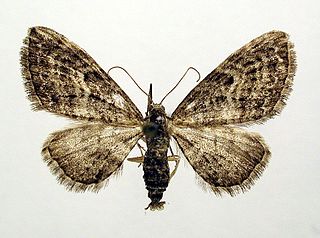
The larch pug is a moth of the family Geometridae. The species can be found in Europe, the Ural Mountains, West and Central Siberia, the Altai Mountains, Transbaikalia, Yakutia, the Far East, Mongolia, Korea, Japan and in North America, from Yukon and Newfoundland to New York and Arizona.
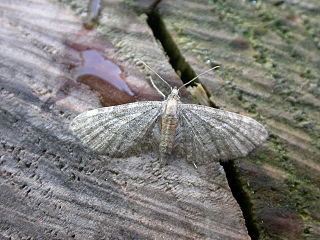
Eupithecia haworthiata, or Haworth's pug, is a moth of the family Geometridae. The species was first described by Henry Doubleday in 1856. It can be found in western, south and central Europe, Asia Minor, the Caucasus and east across the Palearctic to Amur. It occurs in the Alps up to 1800 meters, in the Apennines up to 1400 metres and in the Balkan mountains up to 1500 m above sea level.
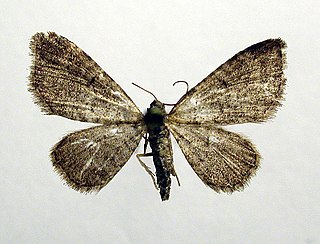
Eupithecia plumbeolata, the lead-coloured pug, is a moth of the family Geometridae. The species can be found all over Europe ranging to the Urals, then through Central Asia to Siberia and to Sayan mountains, the Altai and the Amur. In the Alps, the species occurs up 2000 metres above sea level and in the Pyrenees up to in 2400 metres.

Eupithecia linariata, the toadflax pug, is a moth of the family Geometridae. The species can be found in Europe and from Anatolia to Tajikistan and Iran.

Eupithecia insigniata, the pinion-spotted pug, is a moth of the family Geometridae. The species can be found in Europe and Turkey.

Eupithecia simpliciata, the plain pug, is a moth of the family Geometridae. It is found in the Palearctic realm, from western Europe to north-western China (Xinjiang). The species primarily colonizes wastelands, rubble and abandoned vineyards, and in Asia also salt steppes. In the Alps, the range of altitude extends up to 1200 metres.

Eupithecia analoga is a moth of the family Geometridae. The species can be found from western Europe to the Ural and Siberia. In the north, the range extends north of the polar circle. South, it is found up to the Alps.

Eupithecia conterminata is a moth of the family Geometridae. The species can be found from Fennoscandia and the mountains of central Europe, through the Caucasus to southern Siberia.

Eupithecia selinata is a moth of the family Geometridae. It is found from Japan through the Amur Region, Siberia, the Urals, Caucasus and Russia to western Europe and from southern Fennoscandia to the Alps.
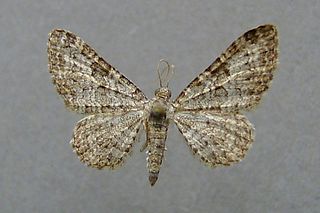
Eupithecia impurata is a moth of the family Geometridae. It is found from the mountainous areas of western, eastern and southern Europe up to Western Asia.
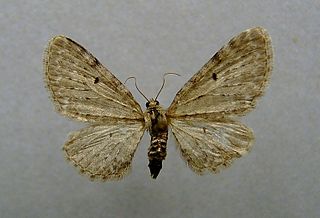
Eupithecia veratraria is a moth of the family Geometridae first described by Gottlieb August Wilhelm Herrich-Schäffer in 1848. It is found from the mountainous areas of Europe and Asia up to Japan.

Eupithecia breviculata is a moth of the family Geometridae. It is found in the Mediterranean region, Switzerland, Hungary, the Near East and North Africa. It is also found in Iran and Turkmenistan.

Eupithecia silenicolata is a moth in the family Geometridae. It is found from southern Europe and Morocco to western Asia, Iran and Pakistan. In the north, the range extends to southern Switzerland, Austria and northern Italy.
Eupithecia limbata is a moth in the family Geometridae. It is found in Italy, France, Slovenia, North Macedonia, Greece and Bulgaria. It is also found in Iran.
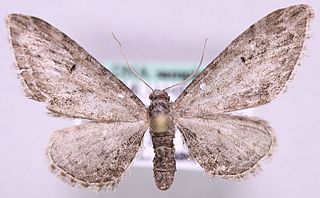
Eupithecia ochridata is a moth in the family Geometridae. It is found in most of Europe, except Ireland, Great Britain, the Benelux, France, Portugal, Austria, Croatia, and northern Russia. It is also present in the eastern Palearctic realm and the Near East.

















